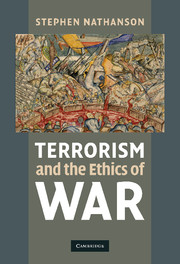Book contents
- Frontmatter
- Contents
- Acknowledgments
- Introduction
- PART I TERRORISM: WHAT'S IN A NAME?
- 1 The problem of defining terrorism
- 2 Defining terrorism
- 3 What makes terrorism wrong?
- 4 Innocence and discrimination
- 5 “Who dun it” definitions of terrorism
- Conclusion: taking stock
- PART II WHY MORAL CONDEMNATIONS OF TERRORISM LACK CREDIBILITY
- PART III DEFENDING NONCOMBATANT IMMUNITY
- PART IV HOW MUCH IMMUNITY SHOULD NONCOMBATANTS HAVE?
- Conclusion: terrorism and the ethics of war
- Bibliography
- Index
3 - What makes terrorism wrong?
Published online by Cambridge University Press: 05 June 2012
- Frontmatter
- Contents
- Acknowledgments
- Introduction
- PART I TERRORISM: WHAT'S IN A NAME?
- 1 The problem of defining terrorism
- 2 Defining terrorism
- 3 What makes terrorism wrong?
- 4 Innocence and discrimination
- 5 “Who dun it” definitions of terrorism
- Conclusion: taking stock
- PART II WHY MORAL CONDEMNATIONS OF TERRORISM LACK CREDIBILITY
- PART III DEFENDING NONCOMBATANT IMMUNITY
- PART IV HOW MUCH IMMUNITY SHOULD NONCOMBATANTS HAVE?
- Conclusion: terrorism and the ethics of war
- Bibliography
- Index
Summary
Now that we have a definition of terrorist acts, it should be possible to pinpoint why it is so widely believed that terrorist acts are wrong and why they are often condemned with special vehemence. The definition specifies four essential features of terrorist acts. Obviously, individual terrorist acts differ from each other in many ways, including where and when they occurred, who carried them out, what weapons were used, and what agenda motivated it. But the general features cited in the definition are features of all terrorist acts. If all terrorist acts are morally wrong, their wrongness must be the result of some or all of these features.
MORAL VS. PSYCHOLOGICAL REASONS FOR CONDEMNING TERRORISM
It is quite natural to see an explanation of the special immorality of terrorism as an answer to the following questions. What makes terrorism so terribly wrong? Why do people condemn terrorist acts with a special vehemence? It is important to see, however, that these questions are not identical. The first is a moral question about the wrong-making features of a type of action. The second is a psychological question about what provokes certain responses in people. In an ideal world, the answers to both questions would be the same. The features that make terrorism wrong would be the same features that explain why people view it so negatively.
- Type
- Chapter
- Information
- Terrorism and the Ethics of War , pp. 30 - 39Publisher: Cambridge University PressPrint publication year: 2010



